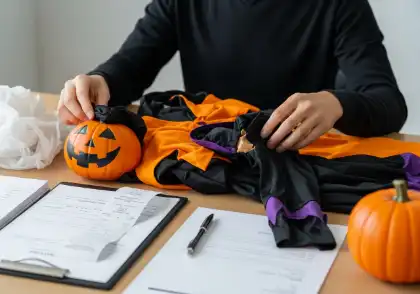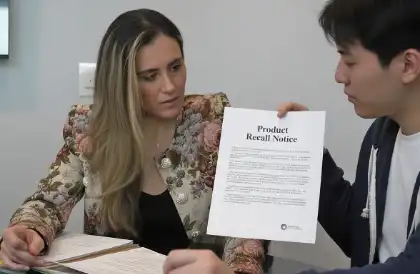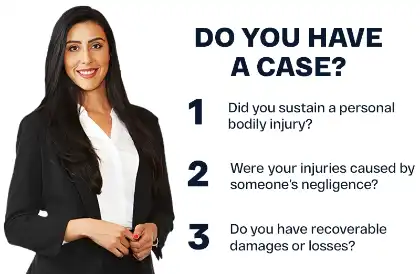TL;DR: Yes, injuries can occur from defective Halloween costumes or masks. Flammable fabrics like polyester blends or nylon can ignite near candles, while loose or poorly made materials may snag, cause tripping, or block vision, which may lead to falls or other accidents.
Table of Contents
Halloween is a time for fun, creativity, and a touch of spookiness. Still, festivities can quickly turn dangerous due to poorly made costumes. Personal injury lawsuits are commonly associated with vehicle accidents and slip-and-fall incidents. However, defective products, such as Halloween costumes, can also lead to liability.
Little-known yet dangerous hazards around Halloween include:
- Masks or headpieces that impair vision.
- Costumes that snag on objects.
- Flammable fabrics or materials near jack-o’-lanterns or candles.
The United States Consumer Product Safety Commission (CPSC) receives reports of preventable injuries every Halloween, including:
- Dislocated shoulders from falls.
- Second-degree burns from open flames.
- Injuries due to costumes and holiday decorations.
It can be easy to believe that something sold at a store is safe to use. Unfortunately, this isn’t always the case. Cheap props and toys sold around Halloween can come with risks. Swords that snap in half, masks with poor ventilation, and makeup containing dangerous substances can all potentially cause injury.
If a product malfunctions and causes injury to you or your loved ones, you may be able to file a product liability claim. You can do so for items that were improperly labeled or lacked warnings about known risks. If a defective costume injures you or your child, contact AK Law Firm at (888) 488 – 1391 or fill out our “Do I Have A Case?” form for a free initial consultation.
Understanding How Costume Defects Can Lead To Fire Or Trip Injuries
With Halloween approaching, parents often shop at local stores for children’s costumes. If you’re one of them, be cautious of poor-quality costumes and their potential to cause harm. If someone sustains injuries due to faulty clothing or unsafe accessories, they may have grounds to pursue compensation through a personal injury claim.
How Defective Costumes And Masks Can Cause Fire Injuries
There are many regulations governing the flammability of blankets, children’s attire, and costumes. That said, it’s easy to think that every costume available follows these rules. However, is that actually the case?
Unfortunately, not all costumes sold at local discount stores and specialty shops follow federal flammability standards. These outfits may cause some children’s trick-or-treating experiences to go up in flames.
According to the CPSC, at least 16 children younger than 15 suffered burn injuries from Halloween costumes between 1980 and 2003. One case involved a fatality. The CPSC has since continued to emphasize the importance of costume safety to prevent accidents on Halloween.
For instance, in 2022, the agency estimated that an average of 3,200 Halloween-related injuries were treated in U.S. hospital emergency departments annually in the three preceding years. According to their report, approximately 20% of these injuries are linked to costumes and other risks, in addition to the more widely discussed fire hazards.
Injuries From Defective Halloween Costumes
Poorly designed Halloween costumes and accessories can pose a serious risk to those wearing them, particularly children. Many costumes made with materials that are prone to catching fire can cause burns. Some potentially flammable Halloween outfits and accessories that may cause injuries include:
- Capes
- Wigs
- Dresses
- Masks
- Costumes with working electronics
- Jack-o’-lanterns
- Candle-lit decorations
According to the National Fire Protection Association, avoid fabrics that billow or trail behind you. For DIY outfits, steer clear of loosely woven fabrics, such as linen and cotton, as they can be difficult to work with. These kinds of clothes can catch fire quickly.
Flammability Of Halloween Costumes And ASTM D1230
Parents and children should be careful around open flames when wearing Halloween costumes. Many might not realize how easily some fabrics can catch fire. Certain clothing materials can ignite quickly and spread flames rapidly, making them highly flammable and dangerous.
The ASTM D1230-22: Standard Test Method for Flammability of Apparel Textiles guides manufacturers. It outlines the procedures for testing the flammability of garment fabrics. Ultimately, ASTM D1230 aims to prevent the use of highly combustible materials in clothing.
The threat of fire can keep you on your toes because it is always a possibility, especially on Halloween. Not all costumes and decorations follow ASTM D1230. These can cause fire-related accidents.
To prevent fire and other hazards, consider these safety guidelines before going out to trick-or-treat:
- Look for costumes made entirely of synthetic materials. Some examples include polyester and nylon.
- Avoid dangling garments, like capes. They are more likely to come into contact with an open flame.
- However, fabrics aren’t the only consideration to keep in mind. Experts further recommend that parents steer clear of glitter, which is also flammable.
- Finally, be aware of your surroundings and stay alert while trick-or-treating.
Trip Injuries Caused By Defective Halloween Costumes And Masks
Costumes can be a lot of fun, but they can also pose unanticipated dangers. Poor design can cause slip-and-fall injuries. For example, a cape that’s too long or a mask that obscures your vision could lead to trips and falls.
Masks that don’t fit well can slip or press against your eyes, making it challenging to see clearly. If manufacturers use poorly fitted materials, debris may get caught in your eyes and cause an injury. Costumes that obscure one eye or restrict your peripheral vision could also put you at risk.
Before wearing a Halloween outfit, do a quick fitting in a safe area. Try moving around while wearing the costume to see how it feels. If the costume includes a mask, test your ability to see your surroundings while wearing it.
Avoid big pieces that do not fit correctly on your or your child’s head. Oversized accessories may obscure your eyesight while moving. Secure any headpieces, scarves, or hats so they do not fall over your or your child’s eyes.
Who Is Responsible For Costume-Related Injuries?
Individuals in California who have been injured by defective Halloween costumes may have legal options. They might be eligible to pursue a personal injury claim under product liability law. This legal principle holds a party liable when their defective product causes harm.
Most product liability cases fall under the doctrine of strict liability. In other words, a manufacturer, designer, or distributor may be held liable, regardless of whether they intended to create a defective product or were aware of its defect. However, some claims can be filed based on negligence.
To pursue a product liability lawsuit, you must establish the following legal elements:
- The product was defective and presented an unreasonable danger for its intended use.
- You used a product as intended or in a way a reasonable person would use it.
- The defect directly and proximately caused your injuries.
- You suffered actual harm or losses because of the defect.
If you can prove these elements, you may have the right to seek compensation as an injured consumer. For example, you could file a claim for medical expenses, pain and suffering, and other damages. An injury attorney can assist throughout the filing process. They will evaluate your case, assess liability, and guide you through the legal requirements.
Proving A Defective Product Claim In Court
In general, there are three ways a Halloween costume may be defective:
- Manufacturing Errors — Something goes wrong during production, causing the costume to stray from its intended design. Even when the original design is safe, a manufacturing mistake can render the product dangerous.
- Design Flaws — The overall design renders a product unsafe, even when manufactured exactly as intended. The question is whether a safer, more practical design could have prevented injury. If it posed an unreasonable risk, the manufacturer may be held liable.
- Failure to Warn — It is the responsibility of producers and retailers to inform customers of known risks associated with their goods. For example, they can provide explicit safety instructions or warnings about flammability and choking hazards. If they fail to do so, they may be held accountable when consumers get injured.
You need to establish a foundation for your claim in defective product cases. Save all incident-related paperwork, including correspondence, receipts, and packaging materials, for future reference. Keeping the defective costume may also be helpful. These items can serve as key evidence when presenting your case. Injury lawyers can review this documentation and help determine how it supports your claim, since a lack of proof may limit your ability to seek compensation.
How To Prevent Costume And Mask-Related Injuries
As California prepares for Halloween festivities, the CPSC reminds everyone to prioritize safety. You can do so when selecting and creating costumes and home decorations. The following precautions can help you and your loved ones safely enjoy the festive spirit of Halloween:
Keep Your Vision Clear
- Costumes and masks shouldn’t block your vision.
- Before heading out, walk and look around while wearing your costume to see if it allows you to see and move freely.
- Consider non-toxic and hypoallergenic face paint or makeup as a safer alternative.
Watch Your Step
- Costumes that don’t fit well can cause trips and falls.
- Avoid wearing costumes with long hems, especially when going out at night for trick-or-treating.
- Wear sturdy, comfortable shoes.
Practice Fire Safety
- Stay away from open flames, such as candles and jack-o’-lanterns.
- Choose flame-resistant costumes.
- Avoid loose or flowing fabrics that may trip you over or brush against lit decorations.
Be Visible At Night
- Apply glow-in-the-dark stickers or reflective tape to shoes, candy bags, and costumes to enhance visibility.
- Provide children with a flashlight or glow sticks to carry.
- Light-colored costumes may be easier for drivers to see at night.
Choose Safe Props
- Props like swords, wands, and accessories should be soft, short, and flexible.
- Avoid realistic-looking or sharp toy weapons, especially for younger children.
Check For Allergens
- Confirm whether a costume or face paint may irritate your skin.
- Check labels for latex or other common allergens.
- Perform a patch test at least one day before using makeup, face paint, or dyes on Halloween.
Frequently Asked Questions
Injured by a defective Halloween costume or accessory? You may be looking for free accident lawyer advice. At Arash Law, we offer free initial consultations to answer your questions. Some of the common inquiries about defective products include the following:
How Does A Recall Affect A Product Liability Claim?
If a defective product injures you, you may wonder whether it was ever recalled. You may be able to use the product’s involvement in a recall as proof in a product liability lawsuit. However, a product recall does not automatically prove the manufacturer’s liability.
Manufacturers may issue recalls for many reasons. One is if they receive reports of injuries or defects. Sometimes recalls are voluntary. Other times, federal agencies like the CPSC initiate them.
In this case, distributors and retailers receive notices to remove the product from store shelves and online listings. Government databases, corporate websites, and media outlets also publicly announce these notices.
Typically, a recall notice lists the product’s name, model, and lot number to identify it. They contain instructions on how to return or dispose of the item properly. They also describe the specific hazard involved.
Does A Recall Automatically Make A Manufacturer Liable?
Not necessarily. Some states allow recall notices as evidence in court. Others may restrict or exclude it. By itself, recall information does not always establish a manufacturer’s liability, even if it is admissible.
The recall may even be used as a defense by a manufacturer. They might argue that the harmed party disregarded the recall notice or continued to use the product anyway. However, a recall also doesn’t automatically shield a company from liability.
What Is The Deadline For Filing A Product Defect Liability Claim?
In California, the statute of limitations for filing a product liability lawsuit is two years. This deadline may start from the date of the injury or when you discovered that a defective product caused you harm. If it passes, you may lose the right to seek compensation.
There are some exceptions to these deadlines. For example, the statute of limitations for cases involving minors may begin once they turn 18.
What Are The Common Injuries Resulting From Defective Costumes?
Poorly designed or defective Halloween costumes contribute to injuries. These may include:
- Serious burns
- Slip-and-fall injuries
- Broken wrists & ankles
- Traumatic brain injury
- Suffocation
- Facial lacerations
- Broken nose & teeth
- Chemical burns
- Eye injuries/loss of eyesight
- Permanent scarring & disfigurement
What Are The Damages I Can Seek For Injuries Caused By Defective Products?
If you can establish the legal elements of a product liability case, you may be able to seek damages such as:
- Past & future medical bills
- Disfigurement & scarring
- Pain and suffering
- Past & future lost wages
- Disabilities & impairments
- Emotional distress
- Diminished quality of life
- A decrease in earning capacity
Several factors can determine the value of your product liability claim. These include the extent of your injury and whether you may have contributed to the incident. Depending on your case, these factors may affect the compensation you can seek. An accident lawyer can evaluate your claim and identify the types of damages you may be eligible to pursue.
What Can I Do After An Injury Related To Halloween Costume Defects?
Have you or a loved one sustained injuries in an accident involving a Halloween costume? It may be wise to take a few general steps to protect your rights and your well-being. For example:
- Prioritize Your Health — If you’re injured, seek medical attention immediately, even if the injury seems minor. A medical professional can assess the extent of your injuries. They can also provide documentation that may be useful in your legal claim.
- Preserve the Costume and Accessories — Keep all files, receipts, communications, receipts of the purchased item, and names. Do not throw away the costume or clothing in question. It may prove useful in establishing your case.
- Document Everything — Take photos of injuries and keep all medical records. You can also collect witness information and other valuable evidence.
- Find Out If There’s a Recall — Search to see if there is a recall on your defective product. The website should provide information on how to return the recalled defective product, obtain a refund, or receive a replacement non-defective product.
- Contact a Personal Injury Attorney — Work with a law firm that handles product liability cases. Arash Law’s product liability attorneys and car accident lawyers can help you evaluate the strength of your claim.
Seek Legal Guidance For Defective Costume Injuries
Although Halloween is a joyful occasion, defective costumes may take away from this fun celebration. A person injured by a faulty costume may be able to file a personal injury claim. Seeking legal guidance and preserving evidence may be beneficial in pursuing compensation.
On behalf of everyone at Arash Law, we hope you have a fun and safe Halloween! If you or a loved one sustains injuries while trick-or-treating, our personal injury lawyers can guide you through your legal options. Our team has worked with many injury victims to help them seek compensation. Contact us at (888) 488-1391, or complete our contact form to schedule a free case review.















































